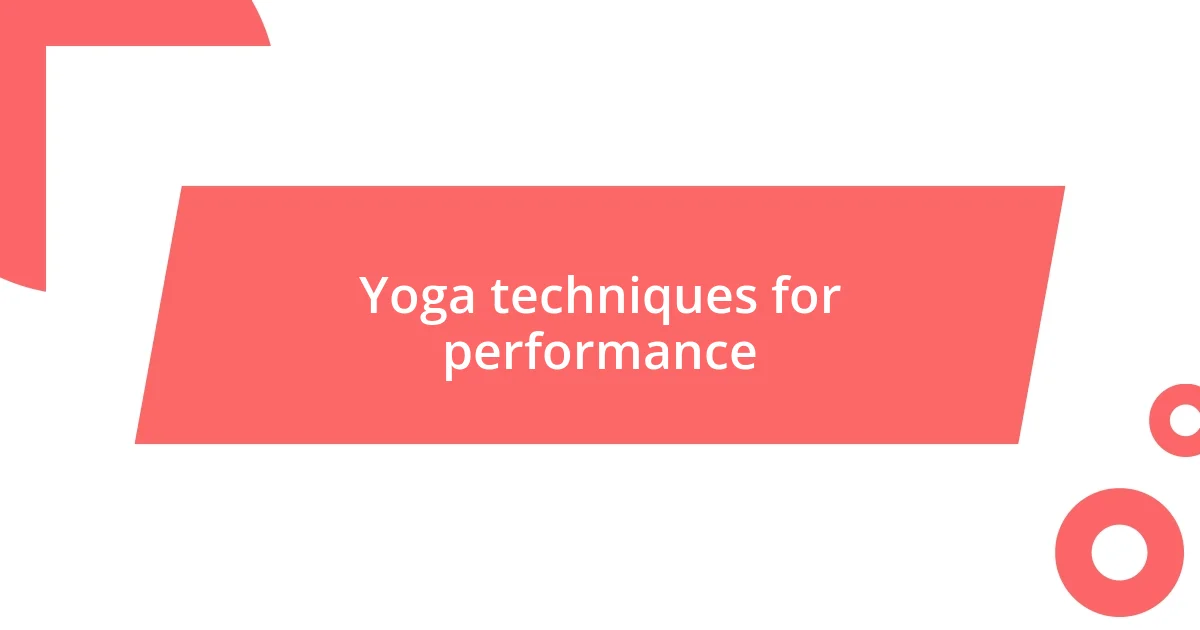Key takeaways:
- Yoga enhances flexibility, mindfulness, and injury prevention, contributing to better athletic performance.
- Specific yoga techniques, such as sun salutations and restorative poses, improve physical readiness and recovery for athletes.
- Customizing yoga routines to target specific sports’ demands can boost performance and mobility significantly.

Benefits of yoga for athletes
One of the most significant benefits of yoga for athletes is enhanced flexibility. I remember when I first started incorporating yoga into my routine; the difference was noticeable almost immediately. My tight hamstrings, which used to hold me back, gradually loosened, allowing me to perform better in my primary sport. Isn’t it fascinating how just a few sessions can lead to such profound changes?
Beyond flexibility, yoga also promotes mindfulness and mental clarity. During tough training sessions, I often found my mind wandering or getting overwhelmed. However, after practicing yoga, I learned to stay present, focusing on my breath and movements. This shift not only helped me in yoga but translated beautifully into my athletic performance. Have you ever noticed how staying focused can change the game?
Lastly, I can’t overlook the injury prevention aspect of yoga. I had a teammate who constantly battled shoulder injuries. After introducing him to yoga, he expressed how much stronger and more balanced he felt. It’s incredible how understanding one’s body through yoga can lead to better control and, ultimately, fewer injuries. Have you considered how yoga might help you in your journey as an athlete?

Yoga techniques for performance
My experiences with specific yoga techniques have truly transformed my performance on the field. For instance, incorporating sun salutations into my warm-up routine not only increased my heart rate but also prepared my muscles for the intense physical demands ahead. I vividly remember one pre-game session; after flowing through those sequences, I felt both energized and centered. It’s remarkable how a sequence of movements can integrate body and mind, setting the tone for an effective performance.
Additionally, using balance-focused poses like tree pose has helped me cultivate stability in my athletic pursuits. I recall practicing it before a big race and noticing how my foot placement improved—not just in the pose itself, but also during sprints. The ability to find balance translates directly to better body control and positioning. It’s like a mental reminder that staying grounded can lead to greater heights, both literally and figuratively. Have you tried balance poses before your competitions?
Finally, restorative yoga techniques can’t be overlooked. After a grueling week of training, I often indulge in gentle stretches and deep breathing, allowing my body to recover and recharge. There was a weekend I dedicated solely to restorative movements, and I felt a remarkable decrease in muscle soreness afterward. This practice of giving myself grace and time to heal was eye-opening. Have you considered how recovery is just as vital as training hard?
| Yoga Technique | Performance Benefits |
|---|---|
| Sun Salutations | Increases heart rate, enhances flexibility and mental focus |
| Tree Pose | Cultivates balance and body control |
| Restorative Yoga | Promotes recovery and reduces muscle soreness |

Improving flexibility through yoga
Improving flexibility through yoga has been a game-changer for me, especially during tight training periods. I used to struggle with reaching my limbs to their full potential, feeling constricted at every stretch. But through consistent practice, I’ve really felt my muscles relax and extend in ways I never thought possible. It’s almost like my body was saying, “Finally, thank you for listening!”
Here are some key benefits of improving flexibility through yoga:
- Enhanced Range of Motion: Increased flexibility allows for deeper, more effective movements in sports.
- Reduced Muscle Tension: Stretching through yoga helps to release built-up tightness, allowing for smoother performances.
- Better Posture and Alignment: Improved flexibility leads to better body mechanics, which is crucial for athletic efficiency.
- Mind-Body Connection: Focusing on breath and movement during yoga cultivates awareness of bodily shifts, contributing to overall performance.
I vividly recall one instance after completing a rigorous week of training when I felt particularly stiff. I attended a gentle yoga class, fully expecting minor relief. But as I moved through the poses, I was surprised by how much more I could stretch compared to my previous sessions. Each breath felt like a renewal, unbinding the tension that had built up over the week. I walked away not just feeling looser, but invigorated, ready to tackle my next challenge. That’s when I truly understood how the physical aspects of yoga intertwine with emotional well-being—it’s all about creating space, both physically and mentally.

Yoga’s role in injury prevention
Yoga plays a crucial role in injury prevention, and I’ve seen it firsthand in my own athletic journey. Incorporating yoga into my routine has not only improved my flexibility but also strengthened the stabilizing muscles that often get overlooked during traditional workouts. I remember several seasons when I was sidelined with nagging injuries; once I committed to regular yoga practice, I noticed those issues fade away. Have you ever had an injury that lingered longer than it should have? I certainly have, and yoga became my go-to remedy.
One aspect that stands out is the importance of mindful movement. Through yoga, I learned to listen to my body and its limits, tuning into the signs of strain before they escalated into an injury. There was a particular session where I pushed my limits in a challenging pose, and instead of forcing it, I took a step back, breathed, and adjusted my alignment. This simple act of self-awareness not only prevented a potential injury but also taught me the value of patience. Isn’t it fascinating how tuning in can actually keep you from falling out?
Furthermore, the emphasis on balance and core stability in yoga cannot be overstated. Engaging in poses that challenge my stability—like warrior poses—has made a noticeable difference in my overall body control. I vividly recall a time when I was preparing for a demanding hike. Thanks to the balance work I’d incorporated, I navigated treacherous terrain with much more confidence than I had in the past. It was a delightful realization that a few mindful moments of practice could translate directly into real-world physical resilience. Have you thought about how the skills learned on the mat could enhance your performance off it? They have certainly changed mine for the better.

Incorporating yoga into training
Integrating yoga into my training routine has been a defining experience. I decided to dedicate one session a week solely to yoga, aiming to complement my regular workouts. The first time I paired my weightlifting with a restorative yoga session, I anticipated unwinding. What I didn’t expect was the profound enhancement in my lifting form. Suddenly, I felt more grounded, stable, and aware of my body’s position—almost like it was a pre-game warm-up just for my mind.
I still remember the day I incorporated sun salutations before I raced. The rhythmic flow of breath and movement energized me; it was like a reset button for my body and mind. As I transitioned into my race, that heightened focus and flexibility proved invaluable. It’s incredible how a simple practice like yoga can elevate your performance in tangible ways. Have you ever felt that unexpected burst of clarity before a big moment? Yoga truly gifted me with that clarity, and I find it to be an essential precursor to competitiveness.
Moreover, I’ve found that short yoga sessions throughout the week can be just as beneficial. I often sneak in a few minutes of stretching during breaks in training or after a long day. These moments create an opportunity to reconnect with my body and unravel tension built up from the day. It’s almost like a mini-vacation from reality—an invitation to pause. Have you tried incorporating micro-practices into your day? Those few minutes make a world of difference and help to keep me feeling fresh and resilient, ready to tackle whatever comes next.

Tailoring yoga for specific sports
Tailoring yoga to specific sports can truly enhance an athlete’s performance and resilience. I remember working with a friend who was a competitive runner; we customized a yoga sequence focusing on hip openers and hamstring stretches. It struck me how these specific poses gave her the freedom to achieve deeper strides and alleviate tension. Isn’t it amazing how a few targeted moves can transform your physical capabilities?
When I began incorporating yoga into my swimming routine, I noticed incredible benefits in my shoulder mobility. I crafted routines that emphasized strength and flexibility for the upper body, especially focusing on poses like downward dog and dolphin. Just last summer at the pool, I felt how those sessions translated into smoother strokes and a more streamlined body position. Have you experienced how a few adjustments in your practice can yield noticeable results? That realization is almost exhilarating.
Each sport has distinct demands, so it’s crucial to assess those needs and adapt yoga accordingly. For instance, after taking up cycling, I created a sequence that included spinal twists and quadricep stretches. The first time I completed the routine, the relief was almost euphoric; I went from feeling tight and cramped to loose and energized. It made me wonder—what could your practice look like if you tailored it to fit your unique sport? Taking the time to customize can truly unlock your full potential.














